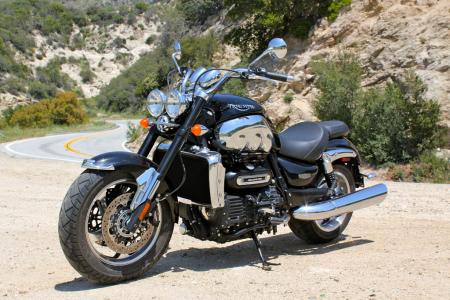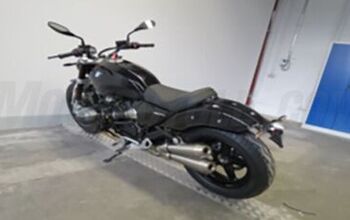2010 Triumph Rocket III Roadster Review - Motorcycle.com
Wrapping up a month-long stint with Triumph's monster-engined Rocket III Roadster, I came away with this summarizing impression: the Roadster is the perfect bike for the American streetbike market.
Now before you go calling me wishy-washy, trying to remind me how in past reviews I've soap-boxed that naked and streetfighter-style bikes are what more riders in the U.S. need under their collective bum, you're right, I've said as much. And I still stand by that mantra.
However, since I've not yet succeeded in my single-handed attempt to convert the majority of American riders over to my way of thinking, I've knuckled under a bit; gone the if-you-can't-beat-'em-join-'em route.
As noted in our recent reviews of the 2010 Star Stratoliner Deluxe and 2010 Honda VT1300 Sabre, Americans have an insatiable appetite for cruisers.
Given our infrastructure of thousands of interstate miles criss-crossing the country and granting access to so much of the wide-open space between our East and West coasts, and our distinctly American mentality of bigger-is-better, I can understand the cruiser domination.
Thusly, a motorcycle with a 2.3-liter engine producing gobs more torque than many economy cars, with styling attitude to match, makes perfect sense in the land of the free, home of the Whopper. Provide a roomy rider cockpit to go with the muscle and you've likely got a winner in the States.
The biggest gets even better
The massive, longitudinally and rigidly mounted inline-Triple that powered the Rocket III, Rocket III Classic and Rocket III Touring didn't receive heaps of changes to its form before entering service in the Roadster, but a few key updates help push the Roadster's all-important output numbers (claimed at the crankshaft) to 163 ft-lbs at 2750 rpm and 146 bhp at 5750 rpm. That's a 14% gain in torque and a 6% boost in ponies over the other Rockets according to Triumph.
A new, CAN-enabled ECU smoothes out throttle pick-up and works with a new pair of freer flowing exhausts that along with looking muscle-car tough are big contributors to the notable gains in engine performance. Catalytic converters – one in each muffler – help the Rocket III mill remain Euro 3 compliant, just as it has been since its 2004 introduction. And yet an emphasis on burning clean doesn't hinder a burly, authoritative exhaust note emanating from the long, chromed cans.
An updated design for transmission gears and the gear selector mechanism is said to make for lighter, more precise shifting action, while the clutch and shaft-drive internals have been upgraded to cope with the increased power and torque output. New cam-drive components were utilized to reduce engine noise.
The Roadster is the first Rocket I've ridden since last saddling up to the original Rocket years ago. My point of reference is at best fuzzy for assessing from the saddle the claimed gains in power, but I can say for certain the Roadster certainly hasn't lost any ground to the previous mega inline-Triple.
Mission accomplished for creating smooth, error-free throttle response; and mountains of torque seem always on tap.
The Roadster easily lights up the mondo 240-section Metzeler ME880 Marathon rear tire, allowing a rider to foolishly but effortless leave a smoky black streak through intersections. And although shifting is nearly superfluous once in top gear – the big inline-Three pulls 5th gear with minimal effort from as low as 1000 rpm! – clutch-lever actuation is light, followed by clean, accurate shifts from the tranny. Refreshing, too, is the limited vibration from a bike with a solid-mount engine that serves as a stressed member of the chassis.
After getting accustomed to big steam from the engine room, what comes to mind next is the hope the Roadster possesses equally big stopping power.
I was nothing short of elated to discover ample braking force and high levels of feel from the Roadster's dual four-piston calipers and 320mm rotor combo. And for the first time on any Rocket, ABS is now standard.
The twin coil-over Kayaba shocks are said to offer a more supple ride by way of springs 20% softer than on the original Rocket III. At the front, the Kayaba 43mm upside-down fork is a Rocket III carryover, but it now comes in a black finish to complement the Roadster’s more aggressive, streetfighterish/muscle-bike stance.
Also softer is a new seat now 10mm higher and 14mm more forward with an off-the-ground height of 29.5 inches (0.4 inches more than the Rocket).
Foot controls also have migrated a skosh. The pegs are nearly 5 inches (123mm) further back and a tick under an inch (22mm) lower. Updated analog speedo and tach gauges include small LCD readouts that display a clock, fuel gauge, gear indicator, real time miles-to-empty counter, dual tripmeters and odo.
It should seem obvious for a big bike such as this, but the rider triangle is roomy. And although foot controls have moved more amidships than the typical feet-flying-forward cruiser layout, there's still lots of legroom.
As for offering a softer ride, perhaps. Ride comfort isn't touring-bike plush, but neither is it overly harsh.
When last I rode a Rocket, naturally I was blown away by the tractor-like amount of torque. But no amount of twisting force could overcome my disappointment in that original Rocket's general handling traits. My experience was a bike that wallowed and was reluctant to steer in a confidence-inspiring, linear manner. Neutral handling was not a characteristic I ascribed to the first Rocket.
However, the new Roadster feels infinitely friendlier to ride than did the standard RIII, even if Triumph makes no mention of chassis changes aimed at improving handling,
The wide handlebar offers great leverage for moderate if not minimal steering effort, and generally the bike's chassis performance belies its claimed 807-pound curb weight (interestingly that's 103 pounds more than what Triumph says were wet weights for the RIII and Classic). Even trundling along at low speeds or performing tight-radius turns is pretty simple; impressive in light of a front tire (150/80 x 17) that's as big as the rear tire found on many light and middleweight streetbikes.
A home away from home for the Rocket
After returning this latest Rocket to its rightful owners, I'm more resolved than ever about my notion that the Rocket Roadster might be the perfect fit for many American cruiser fans.
Recently I got a quick peek at Triumph-supplied sales figures for the Rocket that supports my theory: Of the 18,000 Rocket IIIs built since its inception in the summer of 2004, the United States received one-third (34% to be precise) of that number of Rockets, fully outpacing the next country, the U.K., by 20%.
The U.S. is far and away the leading market for the Rocket. See, it's just like I said: the English-made Roadster belongs in America.
Making the Rocket III Roadster even more appealing is an MSRP surprisingly low for a bike of this caliber: $13,999, a massive $2,200 less than the defunct 2009 Rocket III Classic. The only carryover Rocket is the Rocket III Touring that lists for $16,999.
The Rocket III Roadster is hitting dealers as this is written, available in Phantom Black (think gloss black with minor amounts of metallic flake) or Matte Black color schemes.
Related Reading
2010 Triumph Rocket Roadster Announced
Triumph sales up again in U.S.
2008 Triumph Rocket III Touring Review
Rocket, Roadliner, Road King Shootout
2010 Kawasaki Vulcan 1700 vs. Triumph Thunderbird
All Things Triumph on Motorcycle.com
All Cruiser Reviews on Motorcycle.com
More by Pete Brissette


















![2010 Triumph Rocket III Roadster [video]](https://cdn-fastly.motorcycle.com/media/2023/05/07/11553388/2010-triumph-rocket-iii-roadster-video.jpg?size=350x220)















Comments
Join the conversation